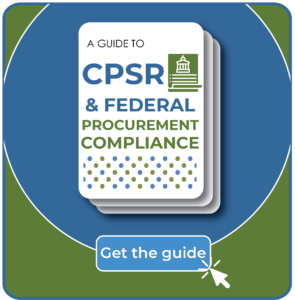Sole Source Justifications – Still in CPSR’s Top 5
Sole Source Justifications are still one of the top 5 deficiencies found during a Contractor Purchasing System Review (CPSR) audit. The best way to be certain you don’t have any findings on Sole Source Justifications is to compete every effort. Procurement professionals know that this is not possible, so the general rule of thumb is to compete at least 60% of your procurements. When competition isn’t possible, you’ll need to file a Source Justification. This article will explain the significance of sole source justifications and give suggestions on what you need to include.
It is important to understand the significance of sole source justifications. Unless an exception applies, FAR 44.204(c) requires Federal Acquisition Regulation (FAR) 52.244-5, Competition in Subcontracting be included in solicitations and contracts expected to exceed the Simplified Acquisition Threshold (SAT).
FAR 52.244-5 requires a contractor to select a supplier/subcontractor on a competitive basis to the maximum practical extent. Competition creates a more level playing field and serves the interests of the government and taxpayers by making sure they pay the lowest price for an item or service.
If an opportunity is not competed, the acquisition is considered to be “Other Than Full and Open” which requires documented justification with management approval. See DFARS 252-244.7001(c)(9). Often times, the choice of a supplier/subcontractor has already been made and sole source justifications are used merely to document that decision. These sole source justifications typically lack sufficient facts and rationale as to why the opportunity could not be competed. Regular and consistent use of sole source justifications could give the appearance to an auditor of fraudulent procurement practices, favoritism, or nepotism and could result in a deficiency during a CPSR.
Effectively documenting your sourcing decision promotes transparency, accountability, and oversight, especially in the event of a dispute or audit. FAR 6.302 addresses the circumstances which permit other than full and open competition. Some of the more commonly used sole source justifications include:
-
- SpendLogic Tip: You must provide documentation that an award to anyone other than the incumbent would cause substantial duplication of cost or unacceptable delays, neither of which would be recovered through competition. Substantial Duplication of Cost must be quantified in dollars, showing that potential competitive savings (assume at least 5%) are outweighed by the cost to conduct that competition. Unacceptable Delays must detail the extent and impact of the delay in a way that shows that the delay was not something that you could have controlled with better planning.
Only one responsible source and no other supplies or services will satisfy requirements
-
- SpendLogic Tip: When soliciting quotes from multiple prospective sources and only one source responds, this counts as “competition attempted” for source justification (but not for price analysis purposes). The key here is that it’s shown that market research was conducted to identify potential bidders and that multiple requests for quote or requests for proposal were sent out.
Approved configuration/Source Controlled Drawing
-
- SpendLogic Tip: If the supplier is the design authority with proprietary designs, data, patent rights, unique skills, or capabilities, explain the specific proprietary elements that limit you to this one source. If this is cited often, you may receive a finding. In this case, be prepared to show how your company plans to remedy the situation to increase opportunities for competition.
Customer directed
-
- SpendLogic Tip: It’s not that we don’t believe the Program Manager but GET IT IN WRITING FROM THE CONTRACTING OFFICER! Without having it in writing, from the government, it doesn’t count.
Unusual and compelling urgency.
-
- SpendLogic Tip: Be sure to document both elements – unusual and compelling. Failure to plan does not support the compelling element. The period of performance for an award using this justification is limited unless there are exceptional circumstances. Note that this method is not used often outside of government agencies.
Other less-common sole source justification methodologies include:
- Industrial mobilization; engineering; developmental, or research capability; or expert services
- International Agreement
- National Security
- Public Interest
- Mentor-Protégé (FAR 52.244-5(b)).
SpendLogic’s Sole Source Justification Module
SpendLogic’s Sole Source Justification module has built in methodologies that can be traced directly to the FAR, as well as some common-sense methodologies that are accepted in CPSRs. This module also has a built-in workflow that allows a Buyer to request completion of a sole source justification from a program POC who can complete the justification in the tool and the Buyer will receive notification that the task has been completed. No more forms to download, fill out, sign, and send back as an attachment. Everything is done in SpendLogic.
By using SpendLogic’s Sole Source Justification module, you can make sure that your procurement file is sufficiently documented with why you chose the source you did, complies with the procurement regulations, and mitigates/eliminates CPSR findings on sole source justifications. To learn more, schedule a quick, no obligation 15-minute demonstration.




 SpendFile Documentation Folders
SpendFile Documentation Folders